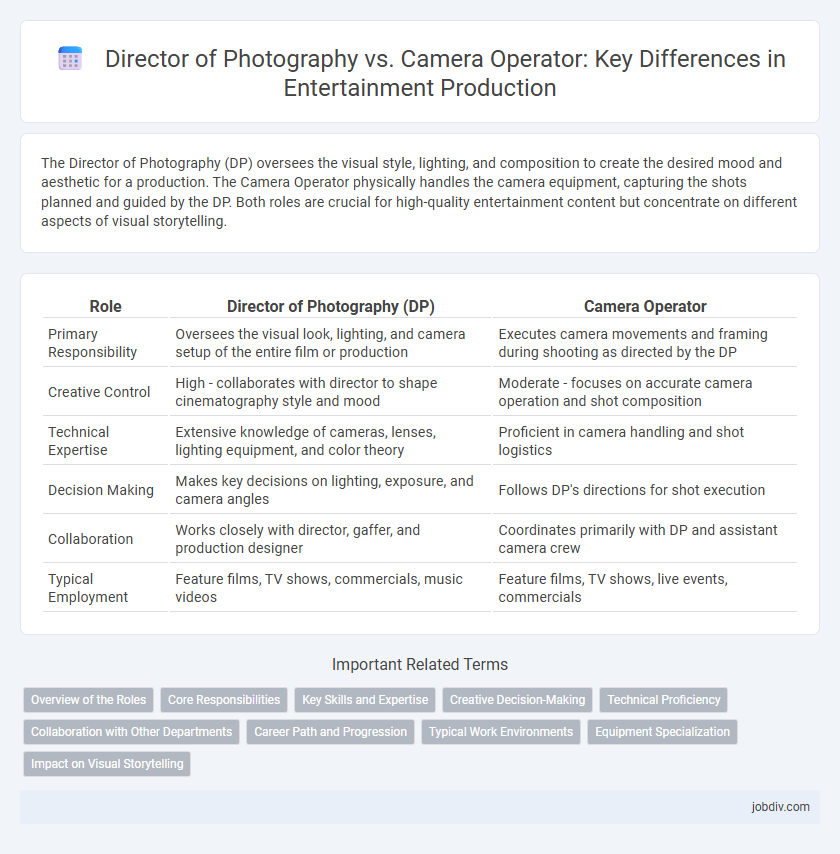The Director of Photography (DP) oversees the visual style, lighting, and composition to create the desired mood and aesthetic for a production. The Camera Operator physically handles the camera equipment, capturing the shots planned and guided by the DP. Both roles are crucial for high-quality entertainment content but concentrate on different aspects of visual storytelling.
Table of Comparison
| Role | Director of Photography (DP) | Camera Operator |
|---|---|---|
| Primary Responsibility | Oversees the visual look, lighting, and camera setup of the entire film or production | Executes camera movements and framing during shooting as directed by the DP |
| Creative Control | High - collaborates with director to shape cinematography style and mood | Moderate - focuses on accurate camera operation and shot composition |
| Technical Expertise | Extensive knowledge of cameras, lenses, lighting equipment, and color theory | Proficient in camera handling and shot logistics |
| Decision Making | Makes key decisions on lighting, exposure, and camera angles | Follows DP's directions for shot execution |
| Collaboration | Works closely with director, gaffer, and production designer | Coordinates primarily with DP and assistant camera crew |
| Typical Employment | Feature films, TV shows, commercials, music videos | Feature films, TV shows, live events, commercials |
Overview of the Roles
The Director of Photography (DP) is responsible for the overall visual look and lighting design of a film or video, collaborating closely with the director to create the desired aesthetic mood. The Camera Operator physically controls and operates the camera equipment during shooting, executing the DP's framing, movement, and composition directives. While the DP oversees creative decisions and technical aspects of cinematography, the Camera Operator focuses on capturing the shots accurately according to the DP's vision.
Core Responsibilities
The Director of Photography (DoP) oversees the visual aesthetics, creating the film's lighting design, shot composition, and camera movement to support the director's vision. The Camera Operator physically handles the camera, executing the shot composition and movements planned by the DoP, ensuring smooth and precise framing during filming. While the DoP focuses on lighting and overall visual storytelling, the Camera Operator's core responsibility is the technical operation and maneuvering of the camera equipment on set.
Key Skills and Expertise
The Director of Photography (DP) oversees the overall visual aesthetic, mastering lighting design, composition, and camera movement to craft the film's mood and tone. Camera Operators specialize in executing precise camera work, handling equipment expertly to capture shots defined by the DP's vision. Both roles require deep technical knowledge, but the DP focuses on creative leadership while the Camera Operator emphasizes operational skill and shot accuracy.
Creative Decision-Making
The Director of Photography (DP) leads the creative vision of a film's visual storytelling, crafting lighting, composition, and mood to evoke emotions and narrative depth. The Camera Operator executes the DP's vision by operating the camera, focusing on framing, movement, and technical precision to capture each shot effectively. Collaborative decision-making hinges on the DP's artistic direction merged with the operator's technical expertise, ensuring cohesive and compelling cinematography.
Technical Proficiency
The Director of Photography (DP) holds comprehensive technical proficiency in lighting, composition, and camera movement to craft the visual style and mood of a film, overseeing the entire cinematographic process. The Camera Operator specializes in executing camera movements and framing with precision, requiring advanced skills in operating various camera rigs and lenses under the DP's guidance. Mastery of complex equipment like Steadicams, cranes, and dollies distinguishes the camera operator's role, while the DP integrates these elements to achieve the director's artistic vision.
Collaboration with Other Departments
The Director of Photography collaborates closely with the production design and lighting departments to craft the visual tone and atmosphere of a film, ensuring every frame aligns with the director's vision. The Camera Operator works in tandem with the DP and grips to execute precise camera movements and framing, translating creative decisions into dynamic shots. Effective collaboration between these roles and other departments such as art, sound, and post-production is essential for seamless storytelling and visual cohesion on set.
Career Path and Progression
A Director of Photography (DoP) typically advances through extensive experience in camera operation, lighting, and visual storytelling, often starting as a Camera Operator or assistant roles. The Camera Operator focuses on executing the DoP's vision by physically controlling the camera during production, which serves as an essential stepping stone for aspiring Directors of Photography. Career progression from Camera Operator to DoP involves mastering technical skills, understanding cinematography principles, and developing leadership abilities to oversee the visual elements of a film or television project.
Typical Work Environments
Director of Photography typically works on set with a large creative team, overseeing lighting design, camera angles, and visual style in studios or outdoor locations. Camera Operators function primarily behind the camera, capturing footage based on the Director of Photography's vision, often navigating challenging environments like moving vehicles or confined spaces. Both roles require adaptability to various conditions, but the Director of Photography focuses more on artistic control while Camera Operators manage technical execution in dynamic settings.
Equipment Specialization
The Director of Photography (DoP) specializes in selecting and overseeing advanced lighting and camera equipment to create the film's visual style, often working closely with high-end lenses, filters, and rigs. In contrast, the Camera Operator focuses on handling the camera itself, ensuring smooth framing and movement using tools like steadicams, cranes, and dollies. Equipment expertise for the DoP centers on creative and technical decisions, while the Camera Operator's specialization lies in operating complex camera gear during filming.
Impact on Visual Storytelling
The Director of Photography shapes the film's overall visual style by controlling lighting, framing, and camera movement to evoke specific emotions and enhance narrative depth. The Camera Operator executes these creative decisions, ensuring fluid and precise camera work that captures the intended visual composition. Together, their collaboration is critical in translating the director's vision into compelling cinematic storytelling.
Director of Photography vs Camera Operator Infographic

 jobdiv.com
jobdiv.com